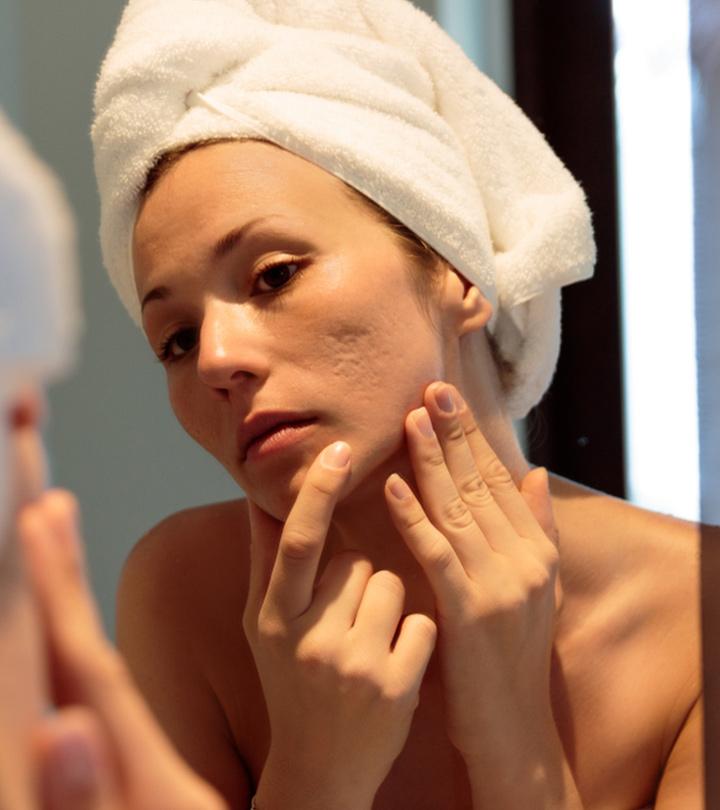Tea Tree Oil For Scabies: How It Works, Usage, And Safety
Don't let those mites afflict your skin with infection; learn to use tea tree oil.

Image: Shutterstock
Scabies affects over 200 million people worldwide (1). And this condition requires immediate attention. Tea tree oil for scabies is considered an excellent remedy for eliminating scabies mites and reducing constant itching, irritation, redness, and discomfort. This article explains how to use tea tree oil to eliminate scabies mites and precautions to follow while using it. Scroll down to learn more.
In This Article
What Is Scabies?

Scabies is not an infection. It is a parasitic infestation caused by Sarcoptes scabei. These are microscopic mites that burrow into your skin, where they make tunnels and lay eggs. This causes redness, itching, blisters, and rashes on your skin. The eggs hatch inside your skin, and the larvae move to the surface and other parts.
This condition is highly contagious and can spread through:
- Skin-to-skin contact
- Sharing personal items (clothes and bed linens, etc.) with the affected individual
 Trivia
TriviaScabicides (prescription medicines for scabies) are usually used to treat this condition. However, scabicides can only kill the mites and not the eggs. Moreover, scabies mites are becoming increasingly resistant to scabicides. Hence, many people resort to natural remedies for treating scabies infestation.
How Is Tea Tree Oil Good For Scabies?

Tea tree essential oil is an extremely effective and natural way to treat scabies. It is mainly due to its antimicrobial, insecticidal, and anti-inflammatory properties (due to the presence of Terpinen-4-ol) that this oil works on many skin conditions, including scabies. Tea tree oil benefits the skin with its ability to soothe inflammation and combat infections makes it a powerful remedy for various skin issues. It is also proven to be effective in managing pruritic skin conditions (skin conditions that cause itching) (2).
A study examined the effect of tea tree oil on scabies mites and concluded that it could be used as an alternative treatment method for controlling scabies in humans as well as animals (3).
Another study claims that 5% tea tree oil is highly effective in killing scabies mites. The terpinen-4-ol in tea tree oil is effective against S. Scabei (4).
Since scabies is contagious, it is crucial to treat your family members too, even if they aren’t infested with the mites.
Note: Dermatologists generally still use medicated malathion solution or permethrin to treat scabies. Scabies can be secondarily infected or associated with eczema, both of which need medical care by an accredited dermatologist. Home treatments with essential oils might result in severe irritation (known as allergic or irritant contact dermatitis).
There are several ways to use tea tree oil for scabies. You may use only tea tree oil or mix it with other ingredients. Scroll down to find some effective remedies to try at home.
How To Use Tea Tree Oil For Scabies

Note: Avoid using pure tea tree oil on your skin. You need to dilute it with a carrier oil and then use it (find dilution ratio mentioned in each recipe). Also, a patch test is mandatory before using any natural ingredient on your skin to check whether you are allergic to it or not. To do a patch test, apply a bit of the ingredient on the skin right behind your ears and leave it on for 24 hours. If your skin doesn’t react, the ingredient is safe to use.
1. Pure Tea Tree Oil For Scabies
Tea tree oil is extremely effective in killing scabies mites and helps to get rid of itch and pain associated with the condition.
You Will Need
- 2-4 tablespoons of carrier oil (you may use sweet almond or jojoba oil)
- 5-10 drops of pure tea tree oil
Method
- Mix both the oils.
- Massage well on your entire body.
- Wash off in the shower (the next day or before you go to bed).
- Follow up with a tea tree oil or neem moisturizer.
How Often?
Do this two times every day.
2. Tea Tree Oil And Neem Oil For Scabies

Neem is widely used in Ayurvedic medicine for treating various skin ailments. Neem extract is a safe way to treat scabies and shows promising results in reducing the infestation (5). You can use neem in any form to treat scabies. But using neem oil for scabies is the most popular option.
You Will Need
- 2-4 tablespoons of cold-pressed neem oil
- 5-10 drops of pure tea tree oil
Method
- Mix both the oils.
- Massage the blend well on your entire body or as needed.
- Wash off in the shower.
- Follow up with a tea tree oil or neem moisturizer.
How Often?
Do this two times every day.
 Quick Tip
Quick Tip3. Tea Tree Oil And Cayenne Pepper
Cayenne pepper doesn’t cure scabies. However, it contains capsaicin, which can help in reducing pain (6). It has a numbing effect that reduces pain caused by scabies.
You Will Need
- 1 cup cayenne pepper (powder)
- 15-20 drops of diluted tea tree oil (dilute it with 2-4 tablespoons of any carrier oil)
Method
- Mix the diluted tea tree oil mixture in cayenne pepper powder.
- Fill your bathtub with lukewarm water.
- Add the cayenne pepper powder and tea tree oil mixture to the water.
- Soak your body until your neck. Ensure the pepper water doesn’t get into your eyes.
- Soak for 20 minutes or until the water gets cold.
- Wash with plain cold water.
- Pat your skin dry.
- Follow up with a tea tree oil or neem moisturizer.
How Often?
Once every day.
4. Tea Tree Oil And Epsom Salt
Epsom salt alone cannot treat scabies. Epsom salt is often used in bath soaks for its rejuvenating effects. It also acts as a dispersant and helps to mix tea tree oil in water.
You Will Need
- 1 cup Epsom salt
- 30 drops tea tree oil
- 2 tablespoons carrier oil (use coconut or olive oils)
Method
- Dilute the tea tree oil with the carrier oil.
- Mix the Epsom salt and oil mixture in a bowl.
- Store it in a jar.
- Prepare a soak with lukewarm water and add the salt mix as required.
- Soak your body until the neck for at least 20 minutes or until the water cools down completely.
- Pat your skin dry.
- Follow up with a tea tree oil or neem moisturizer.
How Often?
Repeat once every day.
5. Tea Tree Oil And Aloe Vera Gel

Aloe vera gel is known for its skin-soothing properties. However, it is also effective for treating scabies. A preliminary study shows that aloe vera gel is as effective as benzyl benzoate in treating scabies (7).
You Will Need
- ½ cup pure aloe vera gel (freshly scooped)
- 2 tablespoons neem oil
- 15-20 drops of tea tree oil
Method
- Blend the freshly scooped aloe vera gel.
- Mix the aloe vera gel, neem oil, and tea tree oil in a bowl.
- Massage the mixture all over your body.
- Let it stay for at least 30 minutes to an hour.
- Wash it off.
- Follow up with a tea tree oil or neem moisturizer.
How Often?
One to two times every day.
6. Tea Tree Oil And Clove Oil
Clove oil is toxic for scabies mites. It contains eugenol, which can kill scabies mites within an hour of contact (8).
Note: A patch test is mandatory for this recipe. Also, clove oil may cause a mild stinging sensation, but it is normal.
You Will Need
- 5-6 drops of pure clove essential oil
- 5-6 drops of pure tea tree essential oil
Method
- Fill up the bathtub with warm water.
- Add 5-6 drops each of clove and tea tree oils.
- Soak in the water for at least 20 minutes.
- Pat your skin dry.
- Follow up with a tea tree oil or neem moisturizer.
How Often?
One to two times every day.
7. Tea Tree Oil And Anise Essential Oil
Anise essential oil is extracted from anise seeds. It has antifungal, antibacterial, and insecticidal properties and is an excellent treatment option for head lice and scabies (9).
Note: A patch test is mandatory for this recipe.
You Will Need
- 5-6 drops of pure anise essential oil
- 5-6 drops of pure tea tree essential oil
Method
- Prepare a warm soak by filling your bathtub with lukewarm water.
- Add 5-6 drops each of tea tree and anise seed essential oils.
- Soak in the water for 20 minutes or more.
- Pat your skin dry.
- Follow up with tea tree oil or neem moisturizer.
How Often?
One to two times every day.
8. Tea Tree Shampoo For Scabies
Apart from the neck and nails, scabies can also affect the head and scalp as well. You can make your own tea tree shampoo at home to help combat scabies on your scalp.
You Will Need
- 1/4 cup of liquid Castile soap
- 1/2 cup of distilled water
- 1 teaspoon of vegetable glycerine
- 2 tablespoons of jojoba oil
- 20 drops of tea tree essential oil
Method
- Take a spray bottle with a nozzle top.
- Combine all the listed ingredients in the bottle.
- Give it a gentle shake before each use.
- Store it in the refrigerator and use it within a week to prevent bacterial growth.
How Often?
Once or twice a week.
Danica, a vlogger, shared her experience of using a mixture of coconut oil and tea tree oil to treat her and her little one’s scabies. She said, “ I put this on my six month old baby. I even kind of put it on my scalp. It will be gone. Head to toe everywhere (i).”
Tea tree oil is a common ingredient found in all types of skin products (like moisturizers, creams, and face washes). Although it is safe to use, you cannot deny the possibility of side effects. Let’s take a look at the risk factors involved.
Tea Tree Oil For Scabies: Are There Any Risks?
Tea tree oil is safe as long as it is diluted, and you do not use it on your skin directly. However, you can be allergic to it. In such cases, it can cause rashes, redness, irritation, and itching.
It is, therefore, always suggested to do a patch test before using any essential oil. Apply diluted oil on the skin right behind your ears or the inside of your arms. Wait for at least 24 hours. If your skin doesn’t react, you can use it safely.
Do not use tea tree oil to treat any condition without consulting a dermatologist, especially if you are considering using it on a child.
If you are using a tea tree oil moisturizer or any other product (ointment or cream) for scabies, make sure that they contain pure tea tree oil with a concentration of at least 5%. Any product with less than this percentage will not be effective in the infestation.
Scabies is highly contagious. Hence, make sure that you use the remedies on all parts of your body and not just the affected area – because there is always a chance that the mites might spread.
Also, clean your belongings, including towels, linens, clothes, and bedding, in hot water before using them. If you live with your family, they will have to undergo the same skincare routine and cleaning process as you, irrespective of whether they have the infestation or not.
Safety Tips To Follow While Choosing Tea Tree Oil For Scabies
You can use either pure tea tree oil or products that contain tea tree oil to kill scabies mites. There are a few safety tips you need to keep in mind in case you are purchasing either of them:
- If you are purchasing any tea tree oil product (cream or lotion), ensure it has a therapeutic percentage of the oil. Check with your doctor about the right percentage before you purchase a product.
- Always use products that have at least 5% tea tree oil.
- When buying pure tea tree oil, check if the label mentions the scientific name (Melaleuca alternifolia) and if it says 100% pure tea tree oil.
- Before purchasing pure tea tree oil, read the label carefully. Check if it says that the oil was derived using the steam distillation process, and the leaves are sourced from Australia (because tea tree plant is a native Australia plant). This will ensure the purity of the product.
Usually, it might take several weeks before you are entirely cured. Though the mites might die within 24 hours, the eggs and fecal deposits can be there on your skin and might take two to four weeks to clear up completely. Continue the treatment until the rashes are gone. If itching and skin irritation continues even after four weeks, you may need a re-examination. Consult a doctor for physical examination and further diagnosis.
Infographic: How To Use Tea Tree Oil With Other Oils To Treat Scabies
Tea tree oil is an effective remedy for scabies. However, you can also use other ingredients with tea tree oil for better results. While we have already mentioned a few, we want to bring your attention to the best oils that work well with tea tree oil in this regard. Check out the infographic below to learn more. Illustration: StyleCraze Design Team
Scabies is a skin infestation caused by mites known as Sarcoptes scabiei that results in itching, blisters, rashes, and redness on your skin. Studies suggest that tea tree oil for scabies is an effective remedy one can use for reducing the symptoms. Its antimicrobial and anti-inflammatory properties make it perfect for killing scabies mites and may also help manage psoriasis symptoms. You can mix tea tree oil with neem oil or aloe vera to treat the affected areas. Ensure you buy a product with 5% tea tree oil for treating scabies, otherwise, it will not be effective. If your scabies persist after a few weeks, consult your doctor for further treatment.
Frequently Asked Questions
What essential oils kill scabies mites?
Tea tree and clove oils are considered the best for killing scabies mites.
How long does it take for tea tree oil to kill scabies mites?
It may take 1 hour to even a few days. This is because initial exposure may kill the mites, but the eggs may remain unaffected. Hence, it might take a few days or weeks to become scabies-free.
Is tea tree oil safe for use on pregnant women with scabies?
Since there is not much research that states the safety of using tea tree oil as a topical treatment for scabies during pregnancy, it is advisable to consult your doctor before making a decision.
Is tea tree oil better than traditional treatments for scabies?
According to research (1), tea tree oil is a natural acaricide (a pesticide for mites) that can also help to control skin inflammation and irritation associated with scabies. This makes tea tree oil a more effective topical treatment when compared to traditional remedies such as turmeric, aloe vera or apple cider vinegar.
Key Takeaways
- Tea tree oil is an effective home remedy to alleviate the symptoms related to scabies.
- You must follow precautions such as patch testing and diluting the oil when using tea tree oil.
- You can dilute the oil with a carrier oil like coconut oil or blend it with skin-soothing ingredients like aloe vera and Epsom salt.
- Along with these home remedies, maintain personal hygiene to prevent the spread of the disease.
Illustration: Tea Tree Oil For Scabies – Does It Work How To Use Risks & Safety

Image: Stable Diffusion/StyleCraze Design Team
References
Articles on StyleCraze are backed by verified information from peer-reviewed and academic research papers, reputed organizations, research institutions, and medical associations to ensure accuracy and relevance. Read our editorial policy to learn more.
- “Recent advances in understanding and treating scabies” Faculty Reviews, US National Library of Medicine, National Institutes of Health.
https://www.ncbi.nlm.nih.gov/labs/pmc/articles/PMC8009191/#:~:text=An%20estimated%20200%20million%20people,response%20which%20is%20intensely%20itchy. - Therapeutic Potential of Tea Tree Oil for Scabies, The American Journal of Tropical Medicine And Hygiene, US National Library of Medicine, National Institutes of Health.
https://www.ncbi.nlm.nih.gov/pmc/articles/PMC4751955/ - In vitro activity of ten essential oils against Sarcoptes scabiei, Parasites and Vectors, Biomed Central.
https://parasitesandvectors.biomedcentral.com/articles/10.1186/s13071-016-1889-3 - Acaricidal Activity of Melaleuca alternifolia (Tea Tree) Oil In Vitro Sensitivity of Sarcoptes scabiei var hominis to Terpinen-4-ol, JAMA Network.
https://jamanetwork.com/journals/jamadermatology/fullarticle/480535 - Studies on the acaricidal mechanism of the active components from neem (Azadirachta indica) oil against Sarcoptes scabiei var. cuniculi, Veterinary Parasitology, US National Library of Medicine, National Institutes of Health.
https://pubmed.ncbi.nlm.nih.gov/24974121/ - Topical capsaicin for pain management: therapeutic potential and mechanisms of action of the new high-concentration capsaicin 8% patch, British Journal of Anaesthesia, US National Library of Medicine, National Institutes of Health.
https://www.ncbi.nlm.nih.gov/pmc/articles/PMC3169333/ - Preliminary study of effectiveness of aloe vera in scabies treatment. Phytotherapy Research, US National Library of Medicine, National Institutes of Health.
https://www.ncbi.nlm.nih.gov/pubmed/19274696 - Acaricidal Activity of Eugenol Based Compounds against Scabies Mites, PLOS One, US National Library of Medicine, National Institutes of Health.
https://www.ncbi.nlm.nih.gov/pmc/articles/PMC2920318/ - Herbal Treatment for Dermatologic Disorders, Herbal Medicine: Biomolecular and Clinical Aspects, US National Library of Medicine, National Institutes of Health.
https://www.ncbi.nlm.nih.gov/books/NBK92761/
Read full bio of Dr. Teo Wan Lin
Read full bio of Anjali Sayee
Read full bio of Shiboli Chakraborti


























Community Experiences
Join the conversation and become a part of our empowering community! Share your stories, experiences, and insights to connect with other beauty, lifestyle, and health enthusiasts.